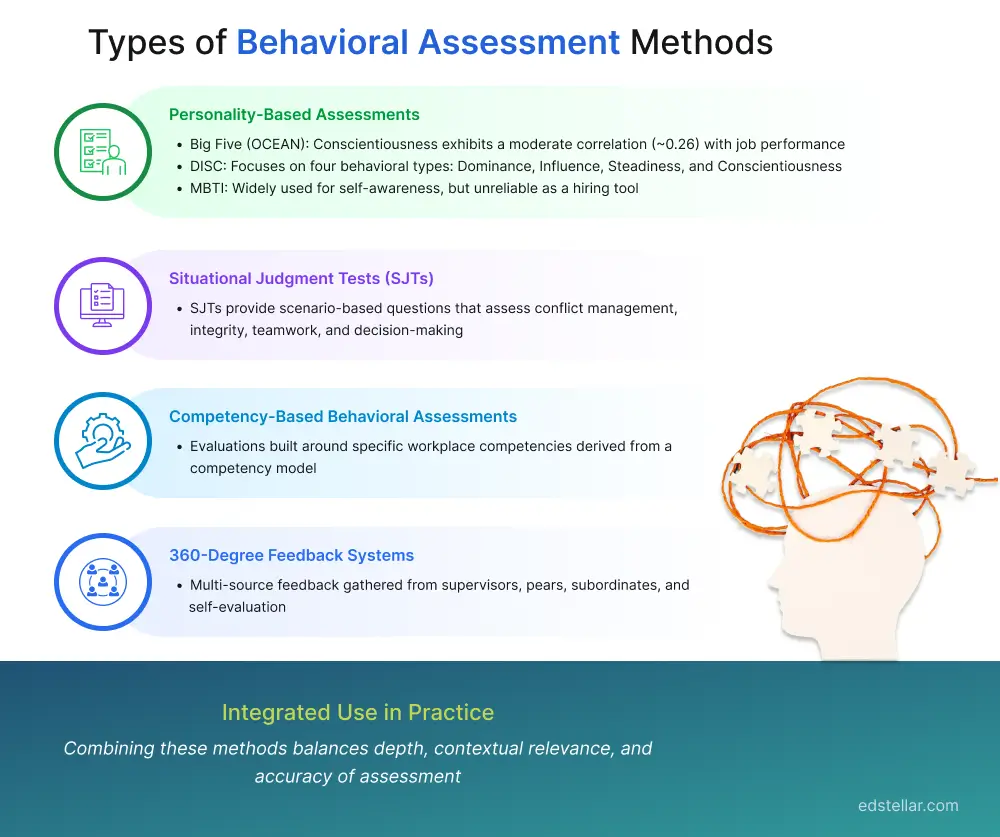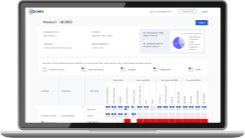
Behavioral assessment is a systematic method used to evaluate an individual’s workplace behaviors, interpersonal interactions, and emotional responses. Amid a rapidly evolving workplace, where hybrid and remote work is the norm, many organizations grapple with a central question: “Is behavioral assessment really necessary?” Traditional methods, such as resumes, technical skills tests, and interviews, capture what a person can do, but offer little insight into how they respond under pressure, adapt to change, or fit within team dynamics, often leading to mismatches, turnover, and limited collaboration.
A 2023 LinkedIn Workplace Learning Report highlights that 83% of L&D professionals view a people-centric culture, grounded in understanding behaviors and employee experiences, as essential for organizational agility and resilience. Complementing this, Gallup's research indicates that organizations with highly engaged employees experience 23% higher profitability compared to those with lower engagement levels.
Recent research further underscores the importance of behavioral insight in hybrid settings. A Stanford-led study of over 1,600 office and hybrid workers found that hybrid teams were as productive as in-office peers, with a striking 33% reduction in attrition for hybrid workers, underscoring the impact of adaptability and well-being on performance. Similarly, a ScienceDirect review confirms that psychometric assessments pinpoint behaviors, like team responsiveness and adaptive work patterns, critical for success in remote and hybrid environments.
In this blog, you’ll discover how scientifically-validated behavioral assessments can serve as a definitive solution. We’ll cover how to identify and select reliable behavioral tools, implement them with fairness and equity, and measure their impact on hiring quality, leadership development, and team performance. By the end, you’ll be equipped to harness behavioral data as a competitive advantage, transforming talent strategy in an era defined by change and uncertainty.
How Behavioral Assessment Differs from Skills Testing
While both skills testing and behavioral assessments are essential tools in the talent evaluation process, they serve distinctly different yet complementary purposes in identifying the right talent for a role.
Understanding the Purpose of Each Assessment Type
- Skills Testing is designed to evaluate a candidate’s technical abilities or job-specific competencies. For instance, an Excel assessment might test for formula creation or pivot table usage, or a programming test might evaluate Python syntax fluency.
- Behavioral Assessment, on the other hand, uncovers how an individual behaves in workplace scenarios. It measures traits like emotional intelligence, teamwork, adaptability, and leadership potential, elements that often predict long-term success more accurately than hard skills alone.
Key Differences Between Skills Testing and Behavioral Assessments
The Science Behind Behavioral Measurement
Behavioral assessments are rooted in deeply established psychological theories and psychometric research, ensuring predictive accuracy and insight.
Core Psychological Theories Behind Behavioral Measurement
- Big Five Personality Traits (OCEAN): Research shows traits like Conscientiousness and Emotional Stability consistently predict job performance across industries. For example, meta-analyses by Barrick & Mount (1991) demonstrated that these traits explained roughly 28% of the variance in managerial effectiveness, with Emotional Stability, Openness, and Conscientiousness being key predictors of task performance and creativity.
- Social Cognitive Theory (Bandura, 1986): This framework highlights how behavior is shaped by ongoing interactions between personal, behavioral, and environmental factors, which are vital for framing how employees adapt and learn in changing workplace contexts.
Validating the Effectiveness of Behavioral Assessments
A meta-analysis published in the Psychological Bulletin confirmed that structured behavioral assessments offer up to 30% higher predictive validity for job performance than unstructured methods like resumes or informal interviews. This is based on Schmidt & Hunter (1998), which analyzed over 85 years of personnel selection research. Although early work by schmidt & Hunter (1998) formed the basis of this claim, recent updates (e.g., Sackett et al., 2022) refined these figures, reinforcing the enduring value of structured, validated behavioral tools.
Emerging Technologies in Behavioral Measurement
Behavioral neuroscience and artificial intelligence now augment traditional psychometrics. For instance, AI-driven platforms can analyze micro-expressions, vocal tone, and decision-making speed, providing more profound insights into traits such as stress response and situational judgment. Of course, deploying these technologies responsibly with ethical oversight is essential.
Types of Behavioral Assessment Methods
As organizations deepen their approach to talent evaluation, behavioral assessments offer a range of sophisticated tools that reveal not just what individuals can do, but how they behave in workplace contexts. Here’s an enhanced overview of the most impactful methods:

1. Personality-Based Assessments
- Big Five (OCEAN): Among personality models, the Big Five is the most empirically supported. For instance, Conscientiousness exhibits a moderate correlation (~0.26) with overall job performance, making it a strong predictor across diverse roles.
- DISC: Focuses on four behavioral types (Dominance, Influence, Steadiness, Conscientiousness). Commonly used in sales and managerial roles to enhance team communication and dynamics.
- MBTI: Widely used for self-awareness, but unreliable as a hiring tool, studies indicate limited predictive validity and low repeatability.
Today’s HR tech integrates multiple personality instruments to paint a more holistic behavioral picture.
2. Situational Judgment Tests (SJTs)
SJTs provide scenario-based questions (e.g., “You’re managing conflicting stakeholder requests, what do you do?”) and ask candidates to select or rank responses.
These tests reliably assess competencies like conflict management, integrity, teamwork, and decision-making. The U.S. office of Personnel management certifies that SJTs are effective for evaluating managerial and leadership behaviors. Modern platforms can further customize scenarios to match organizational culture and role expectations.
3. Competency-Based Behavioral Assessments
These evaluations are built around specific workplace competencies, such as leadership, innovation, or strategic thinking, derived from a competency model. A 2021 Deloitte Human Capital Trends report revealed that when assessments map to defined competency frameworks, organizations achieve a 22% increase in talent-development ROI.
Many modern platforms link these assessments to personalized learning or development pathways.
4. 360-Degree Feedback Systems
In this multi-source feedback approach, input is gathered from an individual’s supervisors, peers, subordinates, and self-evaluation. According to the study by Center for Creative Leadership (CCL), this method produces richer insights when coupled with coaching or development plans. Technology now streamlines the process, ensuring anonymity, analysis, and action-oriented follow-up.
How Companies Use Behavioral Assessments for Hiring and Leadership Development
Combining these methods, for example, SBAs, SJTs, and 360° feedback, enables organizations to strike a balance between depth, contextual relevance, and empirical rigor. This layered approach supports more nuanced hiring, deeper leadership development programs, and stronger talent mobility strategies.
Real-World Use Cases: Turning Behavioral Insights into Measurable Business impact
As organizations evolve in complexity, so must the tools they use to evaluate, develop, and align talent. Behavioral assessments are no longer optional; they are strategic imperatives driving smarter hiring, stronger leadership pipelines, and high-performing teams. From global enterprises to innovation-led startups, leading companies are integrating behavioral science into talent practices to achieve measurable results.
1. Recruitment & Hiring – Unilever
Overview: Unilever transformed its hiring approach for early-career positions by incorporating AI-driven and gamified behavioral assessments through partners like HireVue and Pymetrics, automating initial screening and video interviews
Outcome: According to their own case study, implementing this digital-first process saved over 50,000 hours and more than £1 million annually, while reducing hiring time by 75% and increasing candidate diversity by 16%.
Impact: By standardizing early-stage behavioral evaluation, Unilever reduced bias, improved hiring efficiency, and enriched candidate fit, positioning its workforce strategy for long-term success.
2. Leadership Development – PepsiCo LeAD Program
Overview: PepsiCo’s LeAD initiative utilizes a competency-based assessment framework, incorporating 360° feedback, cognitive and personality assessments, and business simulations to identify high-potential leaders.
Outcome:
- Participants were 1.5–2.5× more likely to be promoted.
- Leadership competencies improved measurably.
High-potential individuals were 3× more likely to be sustained in talent discussions.
Impact: The program increased clarity, fairness, and ROI in leadership development, reducing bias and improving retention among emerging leaders.
3. Team Formation – Google’s Project Aristotle
Overview: Project Aristotle identified psychological safety as a behavioral trait key to high-performing teams. Behavioral assessments helped evaluate team dynamics and fostered optimal team composition.
Outcome: Teams with high psychological safety outperformed others in innovation, engagement, and collaboration.
Impact: Reinforced how behavioral insights, when translated into strategic team design, drive collective effectiveness and sustained team performance.
4. Performance management – Gallup & Coaching
Overview: Rather than directly linking behavioral assessments to performance, Gallup’s extensive research shows that employee engagement, a behavior-driven measure of motivation, commitment, and discretionary effort, is strongly correlated with business outcomes like productivity, profitability, retention, and customer loyalty.
Outcome:
- Highly engaged teams are shown to be 14% more productive, 18% more profitable in sales, and 23% more profitable overall.
- They also experience 51% less turnover in low-turnover environments and 78% lower absenteeism.
Impact: When organizations integrate behavioral insights into performance strategies, especially by equipping managers to coach and engage team members, they can foster deeper commitment, reduce attrition, and amplify productivity. Continuous behavioral feedback and coaching cultivate engaged behaviors that are hard to measure but have clear impact: sustaining high performance, enhancing business outcomes, and building a positive culture.
How to Effectively Implement Behavioral Assessments in the Workplace
Many organizations today are unsure whether behavioral assessments are necessary or how to use them effectively. For some, these tools seem complex, optional, or relevant only for senior roles. As a result, assessments are often underutilized or poorly integrated into talent strategies.
But when implemented strategically, behavioral assessments offer far more than personality insights; they provide data-driven guidance for hiring, leadership development, and team performance. To unlock their full potential, companies must move beyond surface-level adoption and focus on purposeful, outcome-aligned execution.
Selecting the Right Behavioral Assessment
The foundation of successful implementation lies in selecting the proper behavioral assessment based on role criticality, organizational goals, and workforce readiness. Decision-makers should assess tools using structured frameworks that consider scientific rigor, scalability, user experience, and ease of integration with existing HR systems. A well-chosen assessment not only enhances hiring and development decisions but also ensures coherence across the organization’s talent strategy.
Ensuring Fairness in Behavioral Evaluation and Reducing Bias
Equity and compliance are non-negotiables in behavioral evaluation. To ensure fairness, assessments must be validated across diverse demographic groups and aligned with regulations such as the EEOC’s Uniform Guidelines and GDPR. Implementing structured rater training, blind review mechanisms, and regular adverse impact analysis helps minimize unconscious bias.
According to the research by the U.S. Equal Employment Opportunity Commission, all selection procedures must be job-related and consistent with business necessity, especially when adverse impact is identified.
Measuring the ROI of Behavioral Assessments
The impact of behavioral assessments should be measured not only qualitatively but also through clear business metrics. Tracking improvements in turnover rates, new hire productivity, and leadership promotion rates provides tangible proof of value. A benchmark report by Bersin by Deloitte highlights that companies actively measuring assessment ROI achieved up to three times higher hiring quality.
Leveraging Integrated Platforms for Behavioral Assessment Delivery
To maximize efficiency and consistency, organizations should use integrated platforms that support multiple assessment formats. These unified systems streamline implementation, reduce administrative burden, and consolidate data across functions. When behavioral assessments are delivered through such platforms, they enable end-to-end talent visibility and data-driven decision-making that scales with organizational growth.
Conclusion
Behavioral assessments have emerged as strategic differentiators, not just in talent acquisition, but across the entire talent lifecycle, including leadership development, team composition, and performance management. When implemented with scientific rigor, ethical oversight, and supported by measurable outcomes, they enable organizations to significantly improve hiring quality and cultural fit. These assessments also play a pivotal role in strengthening leadership pipelines, enhancing team dynamics, and driving higher levels of productivity and retention.
By aligning behavioral insights with broader organizational goals, companies can make more informed, equitable, and impactful talent decisions. In today's competitive and dynamic business environment, behavioral assessments are no longer optional; they are foundational tools for HR and executive leaders focused on building agile, high-performing workforces.
At Edstellar, we understand the importance of aligning your workforce with your organizational goals. As a trusted corporate training provider, we offer specialized services to help you assess and bridge the skill gaps within your team, whether behavioral, technical, or leadership. Our Skill Matrix Software provides a robust framework to map your employees' competencies and pinpoint areas for improvement. With our L&D Consultancy, we can guide you in creating a talent strategy that fosters growth, enhances collaboration, and drives measurable business outcomes.
Contact us today to learn how Edstellar can help you integrate behavioral insights into your organizational strategy and build a stronger, more agile workforce for the future.
Explore High-impact instructor-led training for your teams.
#On-site #Virtual #GroupTraining #Customized

Bridge the Gap Between Learning & Performance
Turn Your Training Programs Into Revenue Drivers.
Schedule a ConsultationEdstellar Training Catalog
Explore 2000+ industry ready instructor-led training programs.

Coaching that Unlocks Potential
Create dynamic leaders and cohesive teams. Learn more now!


Want to evaluate your team’s skill gaps?
Do a quick Skill gap analysis with Edstellar’s Free Skill Matrix tool

Transform Your L&D Strategy Today
Unlock premium resources, tools, and frameworks designed for HR and learning professionals. Our L&D Hub gives you everything needed to elevate your organization's training approach.
Access L&D Hub Resources.svg)
.svg)



.svg)


.svg)
.svg)
.svg)
.svg)

